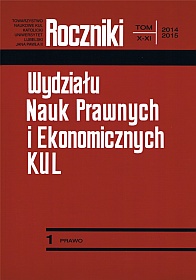Limitation in the Scope of Freedom of Shaping the Content of the Contractual Employment Relationship
Abstract
Shaping the contents of the employment relationship (establishing the conditions of work and pay), according to Art. 11 of the Labor Code is based on the principle of freedom of decision and requires unanimous declarations of the will from both the employee and the employer. This happens on two planes. Firstly, it happens at the stage of concluding the employment relationship, being the effect of negotiations conducted by the parties in order to form a legal bond (this is an obvious question in so far as the parties do not conclude an abstract employment relationship, but one whose content is established in advance). Secondly, a change in the originally established content frequently happens in the course of realization of the employment relationship. At this stage modifications may be made basically in two directions, namely, to the advantage of the employee, or to his disadvantage. They are connected with the duty to respect relevant legal regulations. The aim of the article is to indicate the causes of modifications in the originally established content of the employment relationship and to evaluate the rules of conduct that are defined in the regulations, that set the limits of freedom of the parties in deciding about the shape of the employment contract that binds them.
References
Liszcz T., Prawo pracy, Warszawa 2005.
Sadlik R., Wypowiedzenie zmieniające, „Słowo Pracownicze”, 2006, nr 8.
Rozporządzenie Rady Ministrów z dnia 10 września 1996 r. w sprawie wykazu prac szczególnie uciążliwych lub szkodliwych dla zdrowia kobiet, Dz. U. nr 114, poz. 545 ze zm.
Ustawa o związkach zawodowych z dnia 23 maja 1991 r., Dz. U. z 2001 r., nr 79, poz. 854 ze zm.
Ustawa z dnia 13 marca 2003 r. o szczególnych zasadach rozwiązywania z pracownikami stosunków pracy z przyczyn niedotyczących pracowników, Dz. U. nr 90, poz. 844 ze zm.
Copyright (c) 2015 Roczniki Wydziału Nauk Prawnych i Ekonomicznych KUL

This work is licensed under a Creative Commons Attribution-NonCommercial-NoDerivatives 4.0 International License.

